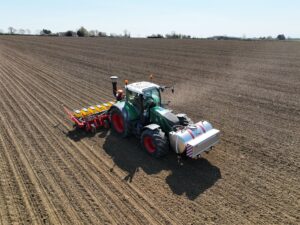How has delayed sugar beet drilling affected herbicide programmes?
14th May 2023
Farmers who have become used to drilling sugar beet in March have had to readjust this spring. The wettest March for 40 years delayed sugar beet drilling well into April on all but the lightest land. Growers must adapt their herbicide programmes accordingly, urges crop protection manufacturer UPL.

The Met Office reported that the UK sugar beet growing area experienced 200% of its average rainfall in March and above-average rainfall in April. This left land destined for sugar beet saturated, with insufficient gaps between the rain for it to dry out. BBRO estimates that 70% of the UK sugar beet crop was drilled up to the 25th of April, with only the heaviest soils still to be drilled. Very little was drilled in March, leaving the bulk of the UK crop being drilled up to a month later than average.
Drilling delay for farmers
Cambridgeshire-based farmer and contractor Tom Jackson of W.R. Jackson & Son did not begin drilling his sugar beet until late April. “As soon as we felt the land was finally ready, we drilled 600ac of sugar beet in 6 days,” says Tom. “Overall, the seed beds were fantastic, and we have had good establishment. One advantage of drilling later is that emergence is much quicker because of the warmer soil temperatures. 80% of it is up now, with the first true leaves emerging on some. However, we have lost a month, so the crop may never quite compensate.”
Tom manages a typical mixture of soil types on the edge of the fens. He has a combination of heavy clay and deep organic soils across his farms. The heavier soils can take a long time to dry out in the spring; cultivating them too early can result in a very uneven seedbed and smearing in the row with the drill. The organic soils are much more friable, and the surface is quicker to dry out, but wet holes can quickly reveal themselves, and Tom has learned to treat them with respect. “We have had to be very patient. I kept digging holes in the fields but felt it was not quite ready earlier in April; there was no sense in pushing it.
“We have not yet put a herbicide on. The priority will be a graminicide on the cover crops sown on the black land as they are now getting quite big. Our sprayer has been busy catching up with wheat T1s, and winter barley T2s will be next on the list. I expect we will make fewer herbicide applications this year because of the later drilling. We will start as soon as the weeds are ready,” adds Tom.
Advice for weed control

Antonia Walker, sugar beet technical specialist
Antonia Walker, UPL’s sugar beet technical specialist, believes that warming soil temperatures and sunnier days will soon see grass and broad-leaved weeds emerging quickly. Not only has the weather disrupted drilling, but it also means that decent spray days are few and far between, meaning early weed control will be challenging. “Where possible, I would recommend a pre-emergence herbicide of Bettix Flo (metamitron) and Oblix 500 (ethofumesate)” advises Antonia. “This will give some flexibility on timing for follow-up post-emergence herbicides.”
Antonia believes programmes should be built around the three key actives for post-emergence broad-leaved weed control: ethofumesate, metamitron and phenmedipham. “Rates can be adjusted to reflect the size species of the weeds present. This will be especially important with the later drilled crops and disrupted spray programmes this spring. The BRRO offers excellent guidance on the relative efficacy of each active against common broad-leaved weeds in their 2023 sugar beet reference book. We have found this approach to deliver the most cost-effective herbicide programme for sugar beet.”
Farmers planning to use Centurion Max (clethodim) for post-emergence grass weed control are urged to consult the stewardship guidelines before applying it. In particular, they should observe the no-spray period and not apply any herbicide five days before or 14 days after application. More details can be found on UPL’s website.



